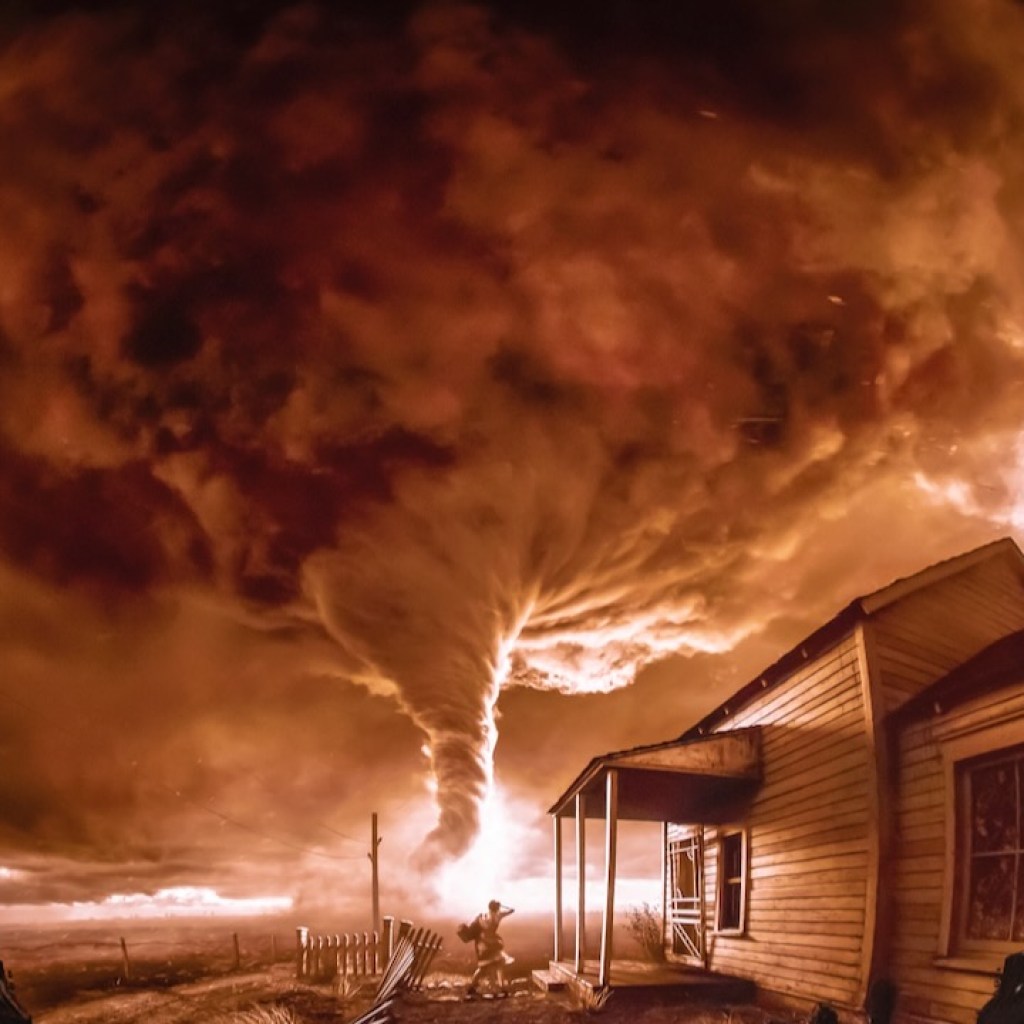It was 8:20 p.m. in Las Vegas, but the sky above me was sunny and blue. As a fan of unique, arguably ridiculous exhibition stunts, I’d sat down for Sphere’s “enhanced” version of The Wizard of Oz at least intrigued by the possibilities of the experience: The original 1939 film, cut down by about 25 minutes, the rest blown up to stretch across a 160,000-square-foot curved dome with additional “immersive” elements.
Lost in translation: A classic film’s soul.
The Sphere presentation begins with a funny little trick. Prior to the show starting, the famous screen was displaying… a screen. Specifically, a photorealistic movie screen framed by curtains, with the rest of the background designed to resemble a traditional theater setting, complete with fake exit signs at the corners. The audience is left to expect, of course, that they’re going to be watching the movie on that (fake) movie screen — before, that is, the film actually begins and one’s gaze is filled entirely by the sepia-tone opening credits, consuming one’s entire field of vision.
A key thing to consider when it comes to Sphere is that it’s a truly unique medium: The incredible immersion made possible by that giant curving screen requires reconsidering the meaning of the frame that defines traditional film projection. Going to a movie theater typically means staring at a bright wall in a dark room, but that was far from the experience I had that night. For one thing, it was very rarely all that dark. For most of the movie, the space was bright as daylight.
Related Video
That’s just one quirk of the Sphere presentation format with legitimate creative possibilities, and using The Wizard of Oz to explore the possibilities of a totally different format has real thematic resonance on a film history level. While the original movie wasn’t the first Technicolor production, it made brilliant use of the technology, and even today it’s still so magical, Dorothy stepping out of her sepia-tone Kansas house into the dazzling splendor of Oz. It’s one of film history’s most iconic choices, because director Victor Fleming uses the literal film medium to communicate to the viewer that one world has been left behind for another.
Here in 2025, there was the opportunity to achieve something mind-blowing on a similar level: Present the Kansas sequences within that movie screen seen before the show started. Wait for the tornado to make full use of the Sphere screen, followed by the transition to color minutes later as Dorothy arrives in Oz. It would have been such an appropriate tribute to the film’s history, while also being thoughtful about the best way to use this new technology in a narrative context.
But no, why bother making a genuinely cool creative choice, when you can instead blast our eyeballs with the biggest screen possible right from minute one? As a first-time Sphere patron, the initial moment of impact was pretty potent, but that moment of wonder would have been so much more powerful had it been tied to an actual story moment, versus Sphere bitch-slapping you across the face with spectacle.
</p>
<p>” data-medium-file=”https://consequence.net/wp-content/uploads/2025/10/wizard-of-oz-sphere-theater.jpg?quality=80&w=300″ data-large-file=”https://consequence.net/wp-content/uploads/2025/10/wizard-of-oz-sphere-theater.jpg?quality=80&w=1024″ src=”https://consequence.net/wp-content/uploads/2025/10/wizard-of-oz-sphere-theater.jpg?quality=80″ alt=”The Wizard of Oz Sphere Review Theater” class=”wp-image-1522247 size-full” width=”1200″ height=”675″ srcset=”https://consequence.net/wp-content/uploads/2025/10/wizard-of-oz-sphere-theater.jpg 1200w, https://consequence.net/wp-content/uploads/2025/10/wizard-of-oz-sphere-theater.jpg?resize=150,84 150w, https://consequence.net/wp-content/uploads/2025/10/wizard-of-oz-sphere-theater.jpg?resize=300,169 300w, https://consequence.net/wp-content/uploads/2025/10/wizard-of-oz-sphere-theater.jpg?resize=768,432 768w, https://consequence.net/wp-content/uploads/2025/10/wizard-of-oz-sphere-theater.jpg?resize=1024,576 1024w, https://consequence.net/wp-content/uploads/2025/10/wizard-of-oz-sphere-theater.jpg?resize=1031,580 1031w, https://consequence.net/wp-content/uploads/2025/10/wizard-of-oz-sphere-theater.jpg?resize=590,332 590w, https://consequence.net/wp-content/uploads/2025/10/wizard-of-oz-sphere-theater.jpg?resize=278,156 278w, https://consequence.net/wp-content/uploads/2025/10/wizard-of-oz-sphere-theater.jpg?resize=173,97 173w, https://consequence.net/wp-content/uploads/2025/10/wizard-of-oz-sphere-theater.jpg?resize=140,79 140w, https://consequence.net/wp-content/uploads/2025/10/wizard-of-oz-sphere-theater.jpg?resize=198,111 198w, https://consequence.net/wp-content/uploads/2025/10/wizard-of-oz-sphere-theater.jpg?resize=674,378 674w” sizes=”auto, (max-width: 1200px) 100vw, 1200px”/></p>
<p id=) The pre-show screen. None of this is real. Photo by Liz Shannon Miller
The pre-show screen. None of this is real. Photo by Liz Shannon Miller
I’d be more forgiving of the big swings attempted here if, on a technical level, the project felt successful. My definition of “success,” unfortunately, includes things like “all of the human faces on screen look like human faces” and “those faces are all looking in the right direction.” Every crowd scene in this adaptation features the potential for nightmare fuel, with the edges of the frame scattered with half-rendered people, none of whom seem actually engaged with anything that’s happening on screen, because the effort to make a flat picture into a curved one did not consider very basic filmmaking tenets like eyelines.
Pointing out how bad things look in the margins might be considered nitpicking. Well, the center of the screen also looked terrible! Specifically in the way that the original actors were basically photoshopped (plopped, really) onto these shiny new CGI backgrounds. When Dorothy walks down the Yellow Brick Road, it simply does not look like her feet are touching the ground. The monkeys aren’t the only ones flying here.
Additionally, Judy Garland’s face has been smoothed to the consistency of skim milk: In rewatching the movie on HBO Max, my 2008-era flatscreen was able to display more details than what they’ve preserved for her spherical screen transfer. Every once in a while, there’d be a glimmer of her having freckles. Then they’d disappear again, a pretty obvious continuity issue, yet far from the movie’s biggest problem. I remember feeling so grateful when Glinda appeared on screen, as actress Billie Burke’s face had been allowed to maintain at least a few lines. Ensuring that she looked vaguely like an actual human being.
